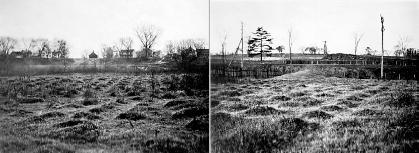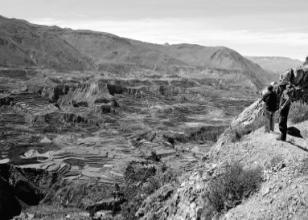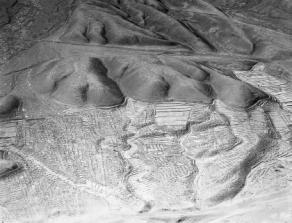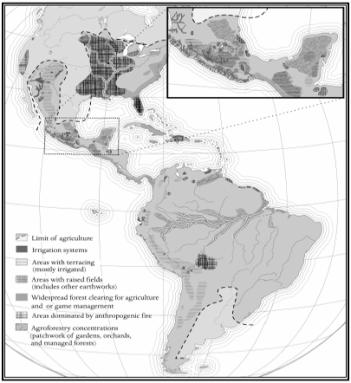1491 (59 page)

Some archaeologists have criticized these conclusions on the grounds that passenger pigeon bones would not be likely to be preserved. If so, their absence would reveal nothing about whether Indians ate the species. But all six Cahokia projects found plenty of bird bones, and even some tiny bones from fish; one turned up 9,053 bones from 72 bird species. “They found a few passenger pigeon bones, but only a few,” Woods told me. “Now, these were hungry people who were very interested in acquiring protein. The simplest explanation for the lack of passenger pigeon bones is a lack of passenger pigeons. Prior to 1492, this was a rare species.”
Passenger pigeons were but one example of a larger phenomenon. According to the naturalist Ernest Thompson Seton, North America at the time of Columbus was home to sixty million bison, thirty to forty million pronghorns, ten million elk, ten million mule deer, and as many as two million mountain sheep. Sixty million bison! The imagination shrinks from imagining it. Bison can run for hours at thirty miles per hour and use their massive, horned skulls like battering rams. Mature animals weigh up to a ton. Sixty million of them would have been more than sixty billion pounds of grouchy, fast-moving mammal pounding the plains.
Seton made his estimate in 1929, and it is still widely quoted today. Ecologists have since employed more sophisticated theoretical tools to produce new, lower population estimates; ethologist Dale Lott put the number of bison in “primitive America” at twenty-four to twenty-seven million in 2002. Nonetheless, most continue to accept Seton’s basic thesis: the Americas seen by the first colonists were a wildland of thundering herds and forests with sky-high trees and lakes aswarm with fish. Increasingly, though, archaeologists demand a caveat. The Americas seen by the first colonists
were
teeming with game, they say. But the continents had not been that way for long. Indeed, this Edenic world was largely an inadvertent European creation.
At the time of Columbus the Western Hemisphere had been thoroughly painted with the human brush. Agriculture occurred in as much as two-thirds of what is now the continental United States, with large swathes of the Southwest terraced and irrigated. Among the maize fields in the Midwest and Southeast, mounds by the thousand stippled the land. The forests of the eastern seaboard had been peeled back from the coasts, which were now lined with farms. Salmon nets stretched across almost every ocean-bound stream in the Northwest. And almost everywhere there was Indian fire.

The Indian impact on American ecosystems was transformative, subtle, and persistent, as suggested by these photographs of remnant Native American maize hills in the outskirts of Northampton, Massachusetts, in the 1920 s. Maize had not grown in these abandoned pastures for centuries, but the handiwork of the land’s original inhabitants remained for those with eyes to see it.

Agricultural terraces like these in Peru’s Colca Valley still cover thousands of square miles in Mesoamerica and the Andes, mute testimony to Native Americans’ enduring success in managing their landscapes.

This grand Indian irrigation system near Pisco, a coastal town south of Lima, fell to developers’ bulldozers—the photograph dates from 1931.
South of the Río Grande, Indians had converted the Mexican basin and Yucatán into artificial environments suitable for farming. Terraces and canals and stony highways lined the western face of the Andes. Raised fields and causeways covered the Beni. Agriculture reached down into Argentina and central Chile. Indians had converted perhaps a quarter of the vast Amazon forest into farms and agricultural forests and the once-forested Andes to grass and brush (the Inka, worried about fuel supply, were planting tree farms).
All of this had implications for animal populations. As Cahokia grew, Woods told me, so did its maize fields. For obvious reasons its farmers did not relish the prospect of buffalo herds trampling through their fields. Nor did they want deer, moose, or passenger pigeons eating the maize. They hunted them until they were scarce around their homes. At the same time, they tried to encourage these species to grow in number farther away, where they would be useful. “The net result was to keep that kind of animal at arm’s length,” Woods told me. “The total number of bison, say, seems to have gone down quite a bit, but they wanted to have them available for hunting in the prairie a couple days’ journey away.”
When disease swept Indians from the land, this entire ecological
ancien régime
collapsed. Hernando De Soto’s expedition staggered through the Southeast for four years in the early sixteenth century and saw hordes of people but apparently didn’t see a single bison. (No account describes them, and it seems unlikely that chroniclers would have failed to mention sighting such an extraordinary beast.) More than a century later the French explorer La Salle canoed down the Mississippi. Where De Soto had found prosperous cities La Salle encountered “a solitude unrelieved by the faintest trace of man,” wrote the nineteenth-century historian Francis Parkman. Everywhere the French encountered bison, “grazing in herds on the great prairies which then bordered the river.” When Indians died, the shaggy creatures vastly extended both their range and numbers, according to Valerius Geist, a bison researcher at the University of Calgary. “The post-Columbian abundance of bison,” in his view, was largely due to “Eurasian diseases that decreased [Indian] hunting.” The massive, thundering herds were pathological, something that the land had not seen before and was unlikely to see again.
The same may have held true for many other species. “If elk were here in great numbers all this time, the [archaeological] sites should be chock-full of elk bones,” Charles Kay, a wildlife ecologist at Utah State, told me. “But the archaeologists will tell you the elk weren’t there.” In middens around Yellowstone National Park, he said, they first show up in large numbers about five hundred years ago, the time of the great epidemics. Until European contact the warm coastline of California was heavily populated, according to William S. Preston, a geographer at California State Polytechnic University in San Luis Obispo. After Columbus everything changed. The Indian population collapsed. Clams and mussels exploded in number; they also grew larger. Game overran the land. Sir Francis Drake sailed into San Francisco’s harbor in 1579 and saw a land of plenty. “Infinite was the company of very large and fate Deere,” he announced. How could he have known that just a century before the shoreline had been thickly settled and the deer much more scarce?

HUMANIZED LANDSCAPES, 1491 A.D.
Complex as it is, this map of Indian effects on the environment is incomplete; no single map could possibly do justice to the subject. The most important omission is fire. I have highlighted some areas where fires deliberately set by Indians effectively controlled the landscape, but this practice played an important ecological role throughout the hemisphere as well, except in wettest Amazonia and northeastern North America. Similarly, scattered clearing, burning, and earth movement for drainage occurred in all agricultural areas—the map indicates only where these factors were especially concentrated. (My depiction of fire-dominated regions in the southern Amazonian highlands is highly speculative, unlike the rest of this map. Researchers have not established where such burning occurred—only where it seems likely.)
Not all of these claims have been endorsed enthusiastically. Kay’s work on elk has drawn especially heavy fire. Elk are big and Indians may have butchered them where they fell, meaning that few elk carcasses would appear in middens. Nonetheless, ecologists and archaeologists increasingly agree that the destruction of Native Americans also destroyed the ecosystems they managed. Throughout the eastern forest the open, park-like landscapes observed by the first Europeans quickly filled in. Because they did not burn the land with the same skill and frequency as its previous occupants, the forests grew thicker. Left untended, maize fields filled in with weeds, then bushes and trees. My ancestor Billington’s great-grandchildren may not have realized it, but the impenetrable sweep of dark forest admired by Thoreau was something that Billington never saw. Later, of course, Europeans stripped New England almost bare of trees.
When the newcomers moved west, they were preceded by a wave of disease and then a wave of ecological disturbance. The former crested with fearsome rapidity; the latter sometimes took more than a century to tamp down, and it was followed by many aftershocks. “The virgin forest was not encountered in the sixteenth and seventeenth centuries,” wrote historian Stephen Pyne, “it was invented in the late eighteenth and early nineteenth centuries.” Far from destroying pristine wilderness, that is, Europeans bloodily
created
it.
By 1800 the hemisphere was thick with artificial wilderness. If “forest primeval” means woodland unsullied by the human presence, Denevan has written, there was much more of it in the nineteenth century than in the seventeenth.
The product of demographic calamity, the newly created wilderness was indeed beautiful. But it was built on Indian graves and every bit as much a ruin as the temples of the Maya.
NOVEL SHORES
I once visited Santarém, in the central Amazon, during the river’s annual flood, when it wells over its banks and creeps inland for miles. Forest paths become canals and people boat through the trees. Farmers in the floodplain build houses and barns on stilts. Stir-crazy cattle in the barns stick their heads out the windows and watch pink dolphins sporting on their doorsteps. Acre-size patches of bobbing vegetation, the famous “floating islands” of the Amazon, drift by. Ecotourists are taken in motorboats through the drowned forest. Kids in dories chase after them, trying to sell sacks of incredibly good fruit.